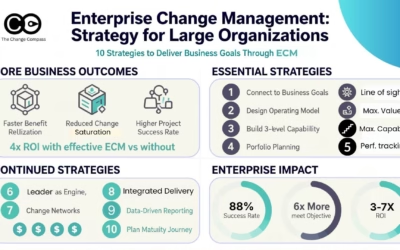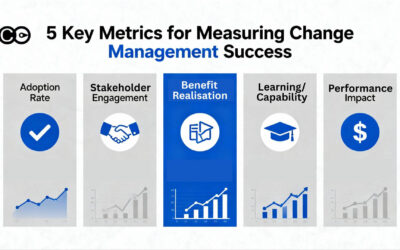Change management practitioners are often tasked with ensuring that transitions are smooth and successful. However, to truly excel in this role, it’s crucial to embrace a systems thinking approach—an understanding that organisations are complex, interconnected systems where every change, including new core business processes and new processes, can create ripple effects throughout. One of the most potent tools for fostering systems thinking is the use of change data within change portfolio management. Here, we will focus on how change data can build interconnectedness across the organisation, enhance the management of change initiatives, and ultimately improve business results.
What is systems change management and why is it important?
Systems change management involves a strategic approach to transforming complex systems, addressing underlying issues rather than just symptoms, including important internal processes. It’s crucial for fostering sustainable development, enhancing organizational efficiency, and driving innovation. By understanding interconnections within systems, organizations can implement effective solutions that lead to long-term positive impacts.
The below are some of the core principles in Systems Thinking and how they may be applied to change portfolio management through data and analysis.
Principle 1: Interconnectedness
At the core of systems thinking is the principle of interconnectedness. Organisations are not merely a collection of individual parts; rather, they consist of various components that interact in complex ways. When change is initiated in one area, it can have unintended consequences in another. For instance, a change in the sales strategy might impact customer service processes, employee motivation, and even supply chain operations. By recognising these interconnected relationships, practitioners can make more informed decisions that take the broader organisational context into account.
In fact, change impact assessment is the process of identifying and ascertaining the linkages across the system. With each change, the various impacts across different processes, people working to support those processes and the systems involved in the processes.
Principle 2: Feedback Loops
Another fundamental aspect of systems thinking is the identification and understanding of feedback loops. These loops can be either reinforcing (positive) or balancing (negative). A reinforcing feedback loop occurs when a change in one part of the system leads to further changes in the same direction, creating a cycle of growth or enhancement. For example, an increase in employee training may lead to improved performance, which in turn boosts morale and reduces turnover, further enhancing overall productivity.
Conversely, balancing feedback loops act to stabilize the system. They can dampen the effects of change, preventing extremes from occurring. Recognising these feedback mechanisms allows practitioners to leverage positive feedback loops to enhance desired outcomes while being vigilant against the negative loops that may emerge, which could undermine the change initiatives.
Here is an example of a feedback loop –
Goal: Prevent stagnation or failure by adjusting strategies based on real-time feedback.
- Use case: Ensuring that deviations or resistance are managed effectively to keep the change on track.
- How it works:
- Collect data from employee surveys, performance metrics, and feedback sessions to understand what’s working or not.
- Identify points of resistance and take corrective actions (e.g., additional training or clarifying leadership vision).
- Example: If employees express frustration with new tools, gather input and refine the rollout to address concerns.
- Collect data from employee surveys, performance metrics, and feedback sessions to understand what’s working or not.
- Identify points of resistance and take corrective actions (e.g., additional training or clarifying leadership vision).
- Example: If employees express frustration with new tools, gather input and refine the rollout to address concerns.
What are key benefits of feedback loops?
- Increased adaptability: Ensures the organisation can react to unforeseen challenges during implementation.
- Engaged workforce: Employees feel more involved when they see their feedback incorporated into the process.
- Sustainable change: Continuous feedback ensures that change efforts stay relevant, preventing them from losing momentum or being abandoned.

Principle 3: Causality
Systems thinking also emphasizes understanding causality—how different components of the organisation influence one another. This perspective is vital in change management, as it shifts the focus from merely addressing symptoms of problems to exploring their root causes. This can be applied throughout the change lifecycle ranging from understanding the impacts across the organisation, through to anticipating resistance and motivation levels to support the change.
Here is an example of applying the principle of causality in systems thinking
Change Initiative: Implementing a New KPI-Based Evaluation System
- Initial Cause: Leaders decide to replace the existing subjective performance reviews with measurable KPIs to improve accountability.
Direct Effect: Employees shift their focus to achieving their KPIs.
- This change seems positive—employees now have clear, measurable targets to meet.
Ripple Effects Across the System:
- Short-term unintended outcome: Employees may begin to focus only on achieving their KPIs, ignoring tasks that are not directly rewarded, such as collaboration or innovation.
- Behavioural impact: Some employees might feel micromanaged or disengaged if they view the new system as rigid or unfair.
- Team dynamics: Competitive behaviour between employees could increase, reducing collaboration and creating silos.
Long-term Causal Feedback:
- Lower collaboration can negatively affect innovation and employee morale, leading to attrition of high performers.
- A balancing feedback loop emerges when HR notices a decline in collaboration scores and recommends revising KPIs to include teamwork-related metrics.
Principle 4: Holistic Perspective
Adopting a holistic perspective is crucial in systems thinking. Instead of viewing the organisation as a set of isolated parts, practitioners should consider the organisation as a dynamic whole. This approach enables better problem-solving and decision-making by considering all relevant factors and their interactions. A holistic view facilitates a deeper understanding of how changes in one area may impact others, ultimately leading to more sustainable and effective change initiatives.
For example, An organisation is running several parallel initiatives under a broader digital transformation effort, including:
- CRM System Implementation
- Agile Ways of Working Initiative
- Cloud Migration for Core IT Systems
- Employee Upskilling Program on Digital Tools
Application of Holistic Perspective
- Identifying InterdependenciesThe CRM system needs to integrate with both legacy IT infrastructure and future cloud platforms, incorporating new features to enhance user experience.
- The agile transformation affects how teams work, influencing the success of the CRM project and cloud migration by demanding faster collaboration cycles.
- The upskilling program needs to ensure employees are trained not only in new digital tools but also on agile practices and cloud-based platforms.
- Avoiding Initiative SilosWithout a holistic view, each project might focus only on its own goals, causing schedule conflicts (e.g., IT resources are overbooked for the cloud migration and CRM deployment).
- Teams might experience change fatigue if initiatives are rolled out simultaneously without coordination. For example, employees may struggle to participate in the upskilling program while also meeting deadlines for the agile rollout.
- Portfolio-Level Governance and PrioritizationUsing a holistic lens, the portfolio management team can sequence projects logically. For example:
- First: Migrate critical systems to the cloud to ensure the CRM implementation has a stable foundation.
- Second: Begin the agile transformation to align working methods before launching cross-functional CRM initiatives.
- Third: Schedule employee upskilling to ensure readiness before key milestones in the CRM and cloud projects.
- Optimizing Resources and Reducing RisksViewing the portfolio holistically allows management to optimize resource allocation (e.g., sharing skilled IT personnel across cloud and CRM projects efficiently).
- By aligning initiatives, the company mitigates the risk of conflicting efforts and reduces change fatigue through coordinated communication and engagement plans.
- The CRM system needs to integrate with both legacy IT infrastructure and future cloud platforms.
- The agile transformation affects how teams work, influencing the success of the CRM project and cloud migration by demanding faster collaboration cycles.
- The upskilling program needs to ensure employees are trained not only in new digital tools but also on agile practices and cloud-based platforms.
- Without a holistic view, each project might focus only on its own goals, causing schedule conflicts (e.g., IT resources are overbooked for the cloud migration and CRM deployment).
- Teams might experience change fatigue if initiatives are rolled out simultaneously without coordination. For example, employees may struggle to participate in the upskilling program while also meeting deadlines for the agile rollout.
- Using a holistic lens, the portfolio management team can sequence projects logically. For example:
- First: Migrate critical systems to the cloud to ensure the CRM implementation has a stable foundation.
- Second: Begin the agile transformation to align working methods before launching cross-functional CRM initiatives.
- Third: Schedule employee upskilling to ensure readiness before key milestones in the CRM and cloud projects.
- First: Migrate critical systems to the cloud to ensure the CRM implementation has a stable foundation.
- Second: Begin the agile transformation to align working methods before launching cross-functional CRM initiatives.
- Third: Schedule employee upskilling to ensure readiness before key milestones in the CRM and cloud projects.
- Viewing the portfolio holistically allows management to optimize resource allocation (e.g., sharing skilled IT personnel across cloud and CRM projects efficiently).
- By aligning initiatives, the company mitigates the risk of conflicting efforts and reduces change fatigue through coordinated communication and engagement plans.
Principle 4: Emergence
Finally, the concept of emergence in systems thinking highlights how complex behaviours can arise from simple interactions among components. The principle of emergence in systems thinking refers to the idea that when individual elements interact, new patterns or behaviours emerge that were not predictable by examining the parts alone. In change portfolio management, this means that the outcomes of managing multiple change initiatives may be different—often more complex or unexpected—than the sum of each individual change project. Emergent behaviours can create both opportunities and risks.
Scenario: Managing a Sustainability Transformation Portfolio
A large organisation launches several interconnected initiatives to become a more sustainable enterprise:
- Carbon Reduction Initiative – Shift to renewable energy and reduce emissions.
- Sustainable Supply Chain Project – Engage suppliers on environmental standards.
- Green Product Innovation Program – Develop eco-friendly products.
- Employee Engagement Initiative – Promote green behaviours among employees.
Application of Emergence
- Unexpected Synergies EmergeEmployees participating in the engagement initiative start identifying operational inefficiencies, such as excess waste, leading to additional cost savings.
- The green product innovation program creates a culture of experimentation that spills over into other departments, resulting in improved collaboration and faster innovation cycles across the organisation, beyond sustainability-focused efforts.
- Emergent Risks and Complex InteractionsSuppliers struggling to meet new sustainability requirements may delay the sustainable supply chain project, impacting both product launches and company operations.
- Employees feel overwhelmed by the number of sustainability programs and resist further change, creating unexpected resistance that spreads to unrelated initiatives, such as digital transformation efforts.
- New Opportunities Emerge from InteractionsAs cross-functional teams work together, new business models emerge. For example, sales and product teams discover that green products appeal to a new customer segment, leading to revenue growth opportunities not originally anticipated in the change portfolio plan.
- Collaborations with suppliers in the supply chain project uncover the potential for joint ventures focused on sustainable technology.
- Employees participating in the engagement initiative start identifying operational inefficiencies, such as excess waste, leading to additional cost savings.
- The green product innovation program creates a culture of experimentation that spills over into other departments, resulting in improved collaboration and faster innovation cycles across the organisation, beyond sustainability-focused efforts.
- Suppliers struggling to meet new sustainability requirements may delay the sustainable supply chain project, impacting both product launches and company operations.
- Employees feel overwhelmed by the number of sustainability programs and resist further change, creating unexpected resistance that spreads to unrelated initiatives, such as digital transformation efforts.
- As cross-functional teams work together, new business models emerge. For example, sales and product teams discover that green products appeal to a new customer segment, leading to revenue growth opportunities not originally anticipated in the change portfolio plan.
- Collaborations with suppliers in the supply chain project uncover the potential for joint ventures focused on sustainable technology.
It may not be possible to forecast or anticipate all types of employee behaviours and reactions to new changes introduced. However, engaging your stakeholders and involving them in the change process may help you identify these in advance.

The Role of Change Data in Building Systems-Thinking Within Change Portfolio Management
Change portfolio management involves overseeing a collection of change initiatives and ensuring that they align with the organisation’s strategic objectives. The integration of change data into this process can significantly enhance systems thinking capabilities.
Creating a Data-Driven Culture
One of the first steps in leveraging change data is to establish a data-driven culture. Practitioners should promote the importance of data in decision-making processes across the organisation. By providing visibility of the changes that are upcoming, they can empower employees at all levels to utilize change data in their daily work. This cultural shift fosters an environment where data becomes a common language, allowing for clearer communication about changes and their potential impacts. However, do note that different type of employees may require different type of data.
Mapping Change Initiatives
Using change data, organisations can create visual maps of their change initiatives. These maps can illustrate how different initiatives are interconnected and highlight the dependencies between them. For example, a visual representation can show how key performance indicators link to a new software implementation, relying on training programs or how changes in one department may impact others. By visualizing these relationships, practitioners can better assess the potential ripple effects of changes and make more informed decisions.
Monitoring and Analysing Feedback Loops
By actively monitoring change data, organisations can identify and analyse feedback loops in real-time and enhance user adoption. This ongoing audit analysis allows practitioners to quickly respond to emerging trends or unintended consequences, including potential performance improvements. For instance, if data shows a decline in employee productivity following a process change, practitioners can investigate and implement corrective actions before the situation worsens. By understanding these feedback loops, organisations can not only react to changes but also proactively shape their outcomes.
Causal Analysis
Incorporating change data into causal analysis enables organisations to identify the root causes of issues. Practitioners can use data analytics to explore the relationships between different components of the organisation, leading to a clearer understanding of how changes impact various outcomes. This data-driven approach allows for more targeted interventions, ensuring that efforts are directed towards addressing the underlying issues rather than merely treating surface-level symptoms.
Holistic Change Portfolio Assessment
When practitioners evaluate their change portfolio, they should adopt a holistic approach that considers the interplay between various initiatives within the change management process. By analysing change data in aggregate, organisations can identify patterns and trends that may not be visible when examining initiatives in isolation. This holistic assessment allows practitioners to prioritise initiatives that align with broader organisational goals, ultimately leading to more effective change management.
Fostering Collaborative Environments
Change data can also be a catalyst for fostering collaborative environments. By sharing insights and findings from change initiatives, organisations can create a culture of collaboration where change agents help teams learn from one another’s experiences. This exchange of information can lead to emergent solutions that drive innovation and improve the process of change outcomes. Additionally, collaborative tools and platforms can be leveraged to facilitate communication and knowledge sharing across departments.
Building Connectedness Across the Organisation
The integration of change data across different types of changes into change portfolio management fosters interconnectedness within the organisation. By emphasising the importance of data and encouraging collaboration, practitioners can create a more cohesive organisational culture that embraces change.
Enhancing Communication
Clear communication is essential for effective change management. Change data provides a foundation for effective communication about initiatives and their impacts to key stakeholders. Practitioners can use data visualizations and reports to communicate progress, challenges, and successes, fostering a sense of shared understanding across the organisation.
Breaking Down Silos
Change data can also help break down silos within the organisation. By sharing data and insights across departments, practitioners can encourage collaboration and foster a sense of unity. This interconnectedness enhances problem-solving capabilities, as diverse teams bring different perspectives to the table, leading to more innovative solutions. Issues may be pre-empted if stakeholders can pick up on impacts that may be missed for example.
Aligning Goals and Objectives
When change initiatives are informed by change data, it becomes easier to align goals and objectives across the organisation. Practitioners can use data to ensure that all initiatives are working towards the same strategic objectives, reducing the likelihood of conflicting priorities. This alignment creates a more focused approach to change management, ultimately leading to improved business results.
Improving Business Results Through Systems Thinking
The application of systems thinking through change data in change portfolio management can lead to substantial improvements in business results. By fostering interconnectedness, enhancing communication, and breaking down silos, organisations can create a more agile and responsive environment.
Increased Agility
Organisations that embrace systems thinking and utilize change data are better equipped to respond to changes in the external environment. By understanding the interconnectedness of their initiatives, practitioners can pivot quickly in response to emerging trends or challenges. This agility is essential in today’s fast-paced business landscape.
Enhanced Employee Engagement
When employees see their work as part of a larger, interconnected system, they are more likely to feel engaged and motivated. By involving employees in the change process and using data to demonstrate the impact of their contributions, organisations can foster a sense of ownership and commitment to change initiatives.
Improved Decision-Making
Systems thinking promotes better decision-making by encouraging practitioners to consider the broader context of their actions. When decisions are informed by change data, organisations can identify potential consequences and make choices that align with their strategic goals. This improved decision-making ultimately leads to more successful change outcomes.
Sustainable Change Initiatives
Finally, the application of systems thinking and change data can lead to more sustainable change initiatives. By focusing on root causes, leveraging feedback loops, and fostering collaboration, organisations can implement changes that are not only effective in the short term but also sustainable over time. This sustainability is crucial for long-term business success.
Change data is a powerful lever that change management practitioners and business leaders can use to foster systems thinking within their organisations. By recognising the interconnectedness of change initiatives, understanding feedback loops, exploring causality, adopting a holistic perspective, and nurturing environments for emergence, organisations can improve their approach to change management solutions. Through these efforts, practitioners can build connectedness across the organisation, ultimately enhancing how change is managed and driving improved business results, as well as ensuring the success of that change. Embracing systems thinking in change portfolio management is not just a best practice; it’s a necessity for organisations seeking to thrive in an ever-evolving business landscape.






